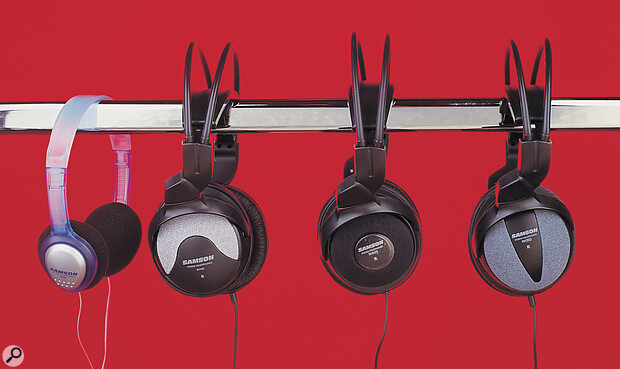Samson have expanded their range with some new headphones: the PH60 and the Rrange, comprising RH100, RH300 and RH600. These are all of the open‑backed variety, a design approach that tends to produce a more pleasingly open sound quality for a given price. However, this makes them unsuitable for foldback monitoring in the studio, because of the potential for sound leakage to colour the recorded sound or even to create howlround.
The PH60s are the bargain end of the range, but their low price doesn't mean they can be dismissed out of hand. The drivers use isotropic ferrite magnets, which are less powerful than the neodymium ones typically used for high‑quality headphones, but they manage to convey a reasonably big, open sound with a pleasantly balanced sound spectrum and reasonable bass response. The claimed frequency response (20Hz to 22kHz) has no tolerances given and, to be honest, I would estimate the response between the ‑3dB points to be rather narrower, especially at the bottom end, though it's perfectly acceptable for non‑critical listening.
The Rseries of headphones all use neodymium magnet assemblies, and all have the same all‑embracing 20Hz‑to‑22kHz frequency response. The over‑the‑ear design of these models applies sufficient side pressure to ensure a good seal without being uncomfortably tight. Plug adaptors are supplied for use with standard quarter‑inch stereo headphone sockets.
The RH100s are the cheapest of the three, but still manage to deliver a good specification and reasonable audio reproduction in a comfortable and durable design. The RH300s have a higher‑quality transducer which achieves a respectable level of performance, with a pleasing balance and an ability to play surprisingly loud. Though higher impedance is often associated with higher performance, the RH300s actually have an impedance of 32Ω, compared to the RH100s' 64Ω. The top‑of‑the‑range RH600s boast slightly larger driver capsules with more responsive diaphragms and an impedance of 40Ω. The sound quality is another notch up from the RH300s, providing a clean and uncoloured sound with a good portrayal of dynamics and a nicely balanced frequency response
Comparing these headphones with my own £100 AKG K240s, even the RH600s revealed , unsurprisingly, a significant resolution gap. The differences were mainly in the ability to extract the more subtle details in recordings, such as the ambient room signatures on simply recorded material. The Samsons also struggled to maintain clarity and individuality between different instrumental lines in complex mixes. As a result, I wouldn't want to have to make critical recording and mixing decisions based on what these Samson headphones reveal.
That sounds rather negative, but these headphones all actually represent good value for money. For general‑purpose listening, I would certainly suggest trying out a Samson model alongside similarly priced Yamaha, Sony, AKG, Sennheiser or Beyerdynamic models. However, you generally get what you pay for in the audio business and headphones are no exception, so I would take Samson's 'professional reference' marketing tag with a very large pinch of salt. Hugh Robjohns

